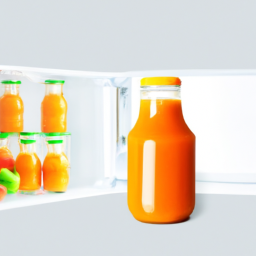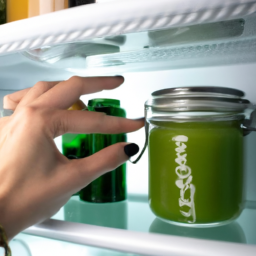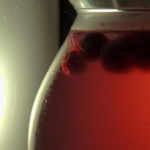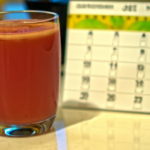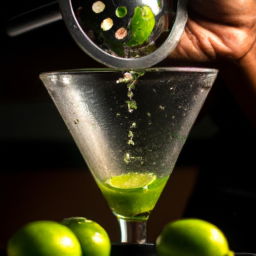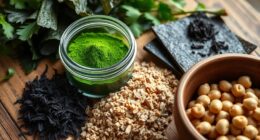Juice always has a place in my fridge. It provides a quick and easy way to get some important vitamins and minerals without having to chop up different fruits and vegetables. However, I often find myself wondering how long juice can stay fresh in the refrigerator, especially since I tend to buy it in bulk.
The answer isn’t as straightforward as you might think. Juice is a perishable item, which means it has a limited shelf life. However, there are many factors that can impact how long it lasts, including the type of juice, packaging, temperature, and duration of storage.
In this article, I’ll dive into the details of juice shelf life and provide some tips for extending its freshness.
Key Takeaways
- Fruit juices can last up to a week in the fridge, while vegetable juices have a shorter shelf life of around 3-4 days.
- Properly preserving juice can help extend its shelf life and retain its nutrients, including refrigeration, avoiding heat and sunlight, and paying attention to expiration dates.
- Freezing juice in ice cube trays or freezer-safe containers can help prolong its shelf life.
- Signs of spoiled juice include an off odor, discoloration, and a sour taste, and it is important to use sight, smell, and taste to determine if juice has gone bad.
Understanding the Shelf Life of Juice
You may be surprised to know that your juice can actually last for up to a week in the fridge, but don’t get too comfortable – after that, it’s time to say goodbye to that delicious, refreshing drink.
The shelf life of juice is dependent on a number of factors, including the type of juice, the preservation methods used, and the expiration date.
To ensure that your juice lasts as long as possible, it’s important to understand how to properly preserve it. This includes keeping it refrigerated at all times, as well as avoiding exposure to heat and sunlight. Additionally, it’s important to pay attention to the expiration date on the juice container, as consuming expired juice can be dangerous to your health.
Understanding these preservation methods and expiration dates can help you to enjoy your juice for longer periods of time.
As for the types of juices and their shelf life, it’s important to note that not all juices are equal. Some juices, such as those made from fresh fruits and vegetables, have a shorter shelf life than others.
In the next section, we will explore the shelf life of different types of juices and how you can best preserve them.
Types of Juices and Their Shelf Life
As a nutrition expert, I believe it’s important to understand the different types of juices and how long they can last in the fridge.
Fruit juices, like orange juice, can last for up to a week if stored properly.
Vegetable juices, like carrot juice, tend to have a shorter shelf life of around 3-4 days.
Freshly squeezed juices, whether fruit or vegetable, should be consumed within 24 hours for maximum freshness and nutrients.
Fruit Juices
When you open a carton of fruit juice, its shelf life in the fridge coincides with the expiration date on the package. However, there are ways to extend the juice’s freshness and preserve its nutrients. Here are some tips to help prolong the shelf life of your fruit juice:
- Keep the juice refrigerated at all times, even before opening it.
- Store the juice in an airtight container to prevent air exposure and oxidation.
- Avoid exposing the juice to direct sunlight or heat.
- Consume the juice within a week of opening it.
- Freeze the juice in ice cube trays or freezer-safe containers for longer storage.
By following these tips, you can help extend the shelf life of your fruit juice while preserving its nutrients.
However, it’s important to note that not all fruit juices are created equal when it comes to shelf life. Some juices, such as citrus juices, have a shorter shelf life than others.
In the next section, we’ll discuss the shelf life of vegetable juices and how to extend their freshness.
Vegetable Juices
Vegetable juices can be a refreshing and nutritious addition to your daily diet. They’re packed with vitamins, minerals, and antioxidants that can help boost your immunity and keep you healthy.
Some of the benefits of vegetable juices include improved digestion, increased energy levels, and better skin health. When it comes to the best vegetables for juicing, you want to choose those that are high in nutrients and low in sugar.
Some of the top vegetables for juicing include kale, spinach, cucumber, celery, and carrots. These vegetables are rich in vitamins A, C, and K, as well as minerals like iron, calcium, and magnesium. They’re also low in calories, making them a great option for weight loss.
As for freshly squeezed juices, they’re another great option for getting all the benefits of fruits and vegetables. However, it’s important to note that freshly squeezed juices should be consumed immediately after juicing to ensure maximum nutritional value.
In the next section, we’ll discuss how long freshly squeezed juices can last in the fridge.
Freshly Squeezed Juices
Nothing beats the refreshing taste and nutritional benefits of freshly squeezed juices that have to be consumed immediately to keep all the goodness intact. But what if you have some leftover juice? How long can you keep it in the fridge before it goes bad? The answer depends on the type of juice and how it was prepared.
In the table below, I have listed some popular juice recipes and their recommended storage time in the fridge. It is important to note that these are just general guidelines and the actual shelf life may vary depending on factors such as temperature, storage container, and freshness of the ingredients. Nevertheless, following these recommendations can help ensure that your juice stays fresh and safe to drink for as long as possible while still retaining its health benefits.
| Juice Recipe | Recommended Storage Time |
|---|---|
| Orange Juice | 1-2 days |
| Apple Juice | 3-5 days |
| Carrot Juice | 3-4 days |
| Beetroot Juice | 1-2 days |
| Green Juice (Kale, Spinach, etc.) | 2-3 days |
Packaging and its impact on juice freshness is an important consideration when it comes to storing juice. In the next section, I will discuss how different types of containers affect the shelf life of juice and what you can do to extend its freshness.
Packaging and Its Impact on Juice Freshness
As a juice enthusiast, I’ve always been keen on finding the best packaging for preserving the freshness of my favorite juices. The three common types of packaging are Tetra Pak, glass bottles, and plastic bottles.
Each type has its own advantages and disadvantages in terms of impact on juice freshness, which I will discuss in this subtopic.
Tetra Pak
You’ll be surprised at how long Tetra Pak juice can last in your fridge! As an AI language model, I’ve been programmed to understand the technicalities of packaging and its impact on juice freshness.
Tetra Pak is a type of packaging material that’s commonly used for juice products. It’s made up of several layers of plastic and aluminum foil, which help to protect the juice from light, oxygen, and other environmental factors that can cause spoilage.
Here are some reasons why Tetra Pak is a popular choice for juice packaging, and why it can help to extend the shelf-life of your juice:
- Tetra Pak is lightweight and easy to transport, which reduces the environmental impact of shipping and distribution.
- The layers of plastic and aluminum foil provide an excellent barrier against light, oxygen, and moisture, which can cause spoilage and deterioration of the juice.
- Tetra Pak is recyclable, and many recycling programs accept it as a common type of packaging material.
- The shape of Tetra Pak cartons is designed to make it easy to pour and drink the juice, without the need for additional cups or containers.
As you can see, Tetra Pak is a versatile and effective packaging material that can help to extend the shelf-life of your juice. However, if you prefer a more traditional and eco-friendly option, glass bottles may be a better choice for you.
Glass Bottles
If you want to experience the satisfying clink of glass and the refreshing taste of chilled juice, grab a glass bottle from the fridge and enjoy. Glass bottles offer several advantages over other types of containers, such as Tetra Pak. First and foremost, glass is non-toxic and non-reactive, meaning it won’t leach harmful chemicals into your juice. Additionally, glass is impermeable, so it won’t allow air or other contaminants to enter the bottle and spoil your juice. Finally, glass is easy to clean and can be reused multiple times, making it an eco-friendly option for juice storage.
However, there are also some disadvantages of glass bottles for juice storage. Glass is heavy and fragile, which makes it difficult to transport and increases the risk of breakage. Glass bottles also tend to be more expensive than other types of containers, which may not be ideal for those on a budget. Additionally, glass is not as flexible as other materials, which means it may not be suitable for juices that require high pressure processing. Overall, glass bottles are a great option for those who prioritize the quality and safety of their juice, but may not be the most practical choice for every situation.
Moving on to plastic bottles…
Plastic Bottles
Now that we’ve discussed the longevity of juice stored in glass bottles, let’s shift our focus to plastic bottles. As previously mentioned, plastic bottles tend to have a shorter shelf life than glass bottles due to their porous nature. This means they’re more susceptible to absorbing flavors and odors from other foods in the fridge, which can affect the taste of the juice.
In addition to the impact on taste, there’s also a growing concern about the environmental impact of plastic bottles. Many consumers are opting for alternatives such as reusable water bottles and glass containers to reduce their carbon footprint. While plastic bottles can be recycled, the process requires a significant amount of energy and resources. As a result, it’s important to consider the environmental impact of our packaging choices when storing juice or any other food or beverage.
Moving on to the next section, temperature and its effect on juice freshness, it’s important to note that the temperature at which juice is stored can greatly impact its shelf life.
Temperature and Its Effect on Juice Freshness
Chilling your juice in the fridge can significantly slow down spoilage and extend its shelf life. Temperature control is crucial in preserving freshness, as it can affect the growth of bacteria and other microorganisms that cause spoilage.
Here are some important things to keep in mind when it comes to temperature and juice freshness:
-
Store your juice at a temperature of 40°F or below to slow down the growth of bacteria and other microorganisms that cause spoilage.
-
Avoid storing your juice in the door of the fridge, as the temperature can fluctuate too much and affect the juice’s freshness.
-
Keep your fridge clean and well-maintained to prevent contamination and ensure that it’s operating at the right temperature.
-
Don’t leave your juice out at room temperature for too long, as this can speed up spoilage and make it unsafe to drink.
Considering the impact of temperature on juice freshness, it’s important to also consider the duration of storage and its impact on the juice’s quality.
Duration of Storage and Its Impact on Juice Freshness
When it comes to preserving the freshness of juice, the duration of storage plays a critical role. In my experience, short-term storage of juices in the fridge can help maintain their quality for up to 3-5 days, depending on the type of fruit used.
For longer-term storage, freezing juice is an effective option, as it can extend the shelf life of juice for several months.
Short-term Storage
Short-term storage for juice typically lasts for 3-5 days in the fridge. However, the juice expiration can vary depending on the type of juice and how it was processed.
For example, fresh juice will spoil faster than pasteurized juice, which has been treated to kill bacteria and extend its shelf life. Additionally, acidic juices like orange or grapefruit juice will last longer than less acidic juices like apple juice.
When storing juice in the fridge, it’s important to keep it in an airtight container to prevent exposure to oxygen, which can cause the juice to spoil faster. Proper storage is key to preserving the quality and freshness of your juice.
By following proper storage techniques, you can extend the life of your juice and enjoy it at its freshest for a few days. Moving on to long-term storage, there are additional steps you can take to keep your juice fresh for an even longer period.
Long-term Storage
If you want to savor your juice for an extended period, it’s wise to consider preserving it in a freezer using a vacuum sealer to seal in the flavors and nutrients. Here are some tips for long-term juice storage:
- Use the best containers for long-term juice storage, such as glass jars or BPA-free plastic containers. Avoid using metal containers as they can react with the juice and alter its taste.
- Label and date the containers to avoid confusion and to keep track of the storage time.
- Experiment with different creative juice recipes to add variety to your storage options. You can mix different fruits and vegetables to create unique and delicious flavors.
Freezing juice is a great way to extend its shelf life and preserve its nutrients. But before we delve into the process of freezing juice, let’s first explore some of the benefits of freezing and why it’s a great option for long-term storage.
Freezing Juice
To preserve your tasty and nutritious juice for later consumption, you should definitely consider freezing it. Freezing juice is one of the most effective juice preservation techniques and has many benefits.
First and foremost, freezing juice can extend its shelf life by several months. This means that you can enjoy your favorite juice even if it is out of season or if you’ve bought it in bulk.
Additionally, freezing juice can help to retain its flavor and nutrient content. When juice is frozen, its cellular structure is altered, allowing it to maintain its taste and nutritional value for a longer period of time.
Moreover, freezing juice is a convenient way to have a quick and healthy drink on hand, as you can easily thaw out a portion of juice whenever you need it.
Overall, freezing juice is a great option for anyone looking to extend the shelf life of their juice while maintaining its taste and nutritional benefits.
As important as it is to know how to preserve your juice, it’s equally important to know when it has gone bad. Signs of spoiled juice include an off odor, discoloration, and a sour taste.
If you notice any of these signs, it’s best to discard the juice as consuming spoiled juice can lead to illness. Therefore, it’s crucial to keep an eye out for these signs and to consume your juice before it spoils.
Signs of Spoiled Juice
As a juice enthusiast, I know that the appearance, smell, and taste of a juice can reveal a lot about its freshness. When it comes to identifying spoiled juice, these three sensory cues are crucial.
The appearance of spoiled juice can range from changes in color to the presence of mold or sediment. Spoiled juice also tends to emit a foul odor, often described as sour or rancid. Finally, the taste of spoiled juice is typically unpleasant and can range from sour to bitter.
As a consumer, it’s important to know these signs in order to avoid consuming spoiled juice and potentially harmful bacteria.
Appearance
Did you know that even though juice may still look and smell okay, it can start to lose its nutritional value after just a few days in the fridge? This is why it’s important to pay attention to the appearance of your juice before consuming it.
Here are a few things to keep an eye out for:
- Juice clarity: If your juice appears cloudy or has sediment at the bottom, this could be a sign that it’s starting to go bad.
- Color changes: If your juice starts to change color, it could indicate that it’s spoiled. Look out for brown, green, or grayish hues.
- Mold growth and bacterial contamination: If you see any mold growing on the surface of your juice, or notice an off smell, it’s best to discard the juice immediately.
By paying close attention to the appearance of your juice, you can ensure that you’re consuming a healthy and safe product.
Now, let’s move on to discussing the importance of smelling your juice before consuming it.
Smell
Take a deep whiff of your juice before drinking it to make sure it smells fresh and fruity, not sour or rancid. Smelling your juice is one of the best ways to determine if it has gone bad.
The smell of spoiled juice is often described as musty, sour, or fermented. This odor is caused by the growth of bacteria and yeast in the juice, which can occur due to a variety of factors.
One of the main causes of smelly juice is improper storage. When juice is exposed to air, it can oxidize and spoil more quickly. Additionally, if the juice is not kept at a consistent temperature, bacteria and yeast can grow more rapidly.
To prevent juice spoilage, it’s important to store it properly. Keep juice in a tightly sealed container in the refrigerator and try to use it within three to five days of opening. If you notice any off smells or flavors, it’s best to err on the side of caution and discard the juice.
As we move into discussing the taste of juice, it’s important to note that the taste can often be closely linked to the smell. A sour or musty smell can indicate that the juice has a similarly unpleasant taste.
Taste
You’ll notice right away if the juice tastes sweet or tart, and the flavor will be the result of the fruit used to make it. But how long the taste lasts is dependent on how well the juice is stored. Maintaining freshness is key to ensuring the juice stays enjoyable to drink, and proper storage techniques can make all the difference.
Here is a table that outlines the recommended storage times for different types of juice:
| Juice Type | Refrigerator Storage Time |
|---|---|
| Freshly Squeezed | 2-3 Days |
| Store-Bought | 7-10 Days |
| Pasteurized | 14-21 Days |
It’s important to note that these are general guidelines and some juices may last longer or shorter depending on the specific brand or type. Regardless, it’s always a good idea to consume juice as soon as possible to ensure maximum freshness. In the next section, I’ll share some tips for extending juice freshness even further.
Tips for Extending Juice Freshness
To keep your juice fresh for longer, store it in an airtight container in the refrigerator. This will help prevent the juice from oxidizing and losing its flavor, like a seal on a jar locking in freshness.
When choosing a container, glass, plastic, or stainless steel are all great options, as long as they have a tight-fitting lid. Avoid using containers made of materials that can react with the juice, such as copper or aluminum.
Another way to extend the freshness of your juice is to add a little bit of lemon juice to it. Lemon juice contains citric acid, which can help preserve the juice and prevent the growth of bacteria.
Additionally, make sure to keep your fridge clean and at the right temperature, as a dirty or too-warm fridge can encourage the growth of bacteria and spoil your juice.
By following these tips, you can extend the life of your juice and enjoy it for longer periods of time.
As you continue to store your juice, it’s important to use your senses to determine its freshness. In the next section, we’ll explore how to use sight, smell, and taste to determine if your juice has gone bad.
Using Your Senses to Determine Juice Freshness
Using your senses is the key to determining if your juice is still fresh and safe to consume. While the expiration date on the packaging is a good starting point, it doesn’t always reflect the actual freshness of the juice.
There are various freshness indicators you can observe to assess the quality of your juice. First, take a look at the color of the juice. If it has significantly darkened or appears cloudy, it may have started to spoil. Then, smell the juice. If it has a sour or off odor, it’s likely past its prime. Lastly, taste a small amount of the juice. If it has a funky or unpleasant taste, it’s time to discard it.
By using your senses, you can avoid consuming juice that has gone bad and potentially causing foodborne illness. When it comes to determining when to discard juice, it’s important to keep in mind that the freshness indicators listed above are just that – indicators. If you’re unsure about the quality of the juice, it’s always better to err on the side of caution and throw it away.
In the next section, we’ll discuss some guidelines for determining when it’s time to discard juice based on how long it’s been in the fridge.
When to Discard Juice
Wondering when it’s time to toss that bottle in the trash? Determining the expiry of juice can be tricky, but there are a few key things to keep in mind.
First, always check the expiration date on the bottle or container. This will give you a general idea of how long the juice can last. However, it’s important to note that this date is not always accurate, especially if the juice has been opened or if it’s been stored improperly.
To ensure optimal freshness, it’s recommended to store juice in the refrigerator at a temperature between 32-40°F. This will help slow down the growth of bacteria and prevent spoilage. However, even if stored properly, juice can still go bad.
Signs that it’s time to toss the juice include a sour or off smell, a change in color, or a cloudy appearance. If you notice any of these signs, it’s best to err on the side of caution and discard the juice.
Frequently Asked Questions
Can I freeze juice to make it last longer?
Yes, freezing fruit juice is a common Juice Preservation Technique. It can extend the shelf life of juice by several months. However, it’s important to leave some room in the container for expansion during freezing.
How long can freshly squeezed juice last in the fridge compared to store-bought juice?
Freshly squeezed juice, unlike pasteurized store-bought juice, retains more of its nutrients due to minimal processing. However, it has a shorter shelf life in the fridge, typically 2-3 days compared to store-bought juice that can last up to 2 weeks.
Is it safe to drink juice that has been left out of the fridge overnight?
Leaving juice out of the fridge overnight poses health risks due to bacterial growth. It is not safe to drink as harmful bacteria can multiply rapidly, leading to food poisoning and other illnesses.
Can I mix different types of juice together and still expect them to last as long as they would separately?
Mixing juices can create unique flavor combinations, but it may affect their shelf life. Factors like acidity, preservatives, and packaging can impact how long they last. It’s best to store them separately and consume them within their respective expiry dates.
Does the expiration date on the juice bottle indicate when the juice will start to spoil, or when it will be unsafe to consume?
The expiration date on a juice bottle indicates when the juice will start to spoil, but not necessarily when it will be unsafe to consume. The difference between spoilage and safety should be noted when consuming expired juice.
Conclusion
In conclusion, understanding the shelf life of juice is crucial in ensuring that you consume safe and fresh beverages. The type of juice, packaging, temperature, and duration of storage all play a significant role in determining the freshness of your juice. Signs of spoiled juice include changes in color, odor, and taste.
To extend the freshness of your juice, consider refrigerating it immediately after opening, using airtight containers, and consuming it within the recommended time frame. Always trust your senses to determine if the juice is still safe to consume.
Remember, consuming spoiled juice can lead to foodborne illnesses. So, the next time you ask yourself, "how long can juice last in the fridge?"remember these tips to ensure that you enjoy fresh and safe juice.
Ilana has been a vegan for over 10 years. She originally made the switch for health reasons, but soon found herself becoming more and more passionate about the ethical and environmental implications of a vegan lifestyle. Ilana is the author of The Graceful Kitchen, a blog all about veganism. She loves to cook up delicious and nutritious vegan meals, and share her recipes with others who are interested in leading a cruelty-free life. Ilana is also a strong advocate for using whole foods as the foundation of a healthy diet, and believes that going vegan is one of the best ways to achieve this.
